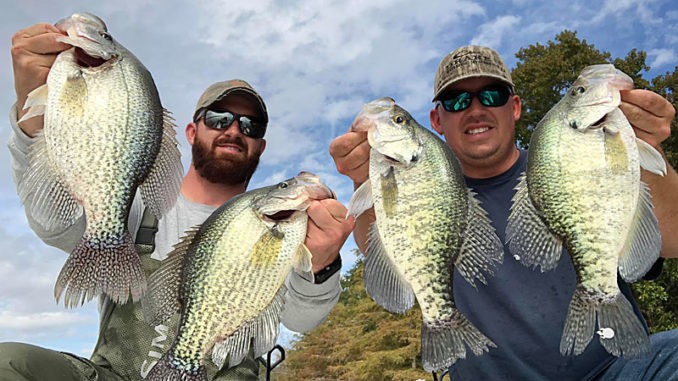
Black or white, they’re spread all over — and among the most-popular fish among anglers in this country
Crappie are one of the most popular gamefish among anglers in America. These fish are found in all 48 states on the continent, and they are found in many different types of water. They are members of the sunfish family, which also includes bass and bream.
Many anglers don’t realize it, but crappie come in two varieties: black and white. Both species are similar in size and shape, and they both have similar diets. They spawn at pretty much the same times, mostly during early spring. Males of both varieties create nests during breeding season, then guard the eggs and fry. Females lay anywhere from 5,000 to 60,000 eggs that hatch in two to five days.
Crappie are abundant in most lakes and in some rivers. Pond managers are hesitant to stock them in farm ponds because they can overpopulate small bodies of water very quickly. These fish provide fun fishing, and also excellent table fare. The meat is white and flaky. They are most often prepared fried.
Both varieties have similarities, but also some distinct differences
White crappie are generally lighter in color and have vertical, black stripes. Black crappie usually have darker bodies and have black splotches throughout. However, due to variations in water clarity and quality, their coloration can be much more subdued, so the distinguishing features can be difficult to see. The most-reliable way to determine which species is which, count the spiny dorsal fin rays. Black crappie have seven or eight; white crappie have five or six.
Smaller fish make up the majority of a crappie’s diet. They also eat insects, crustaceans and zooplankton. Anglers targeting crappie often use live minnows. Artificial lures like small jigs and spinners are also good. Some anglers anchor their boats and fish vertically over brush piles. Others troll from one brush pile to the next using multiple rods.
Crappie can live in a variety of depths, and they move up and down in the water column throughout the year. Many are caught in shallow water during the spring and early summer, then head to deeper water throughout the hottest and coldest months. Many anglers consider them as spring and fall fish and rarely pursue them in the heat of summer or the dead of winter. But recently, advances in electronics have spurred a growth in fishing for them during those times as well.
December is great for crappie; many anglers construct beds for them with discarded Christmas trees once the holiday passes.
Crappie are known by several other names, including: papermouth, speck, speckled bass, speckled perch, strawberry perch, strawberry bass, and across Louisiana, sac-a-lait.
In Louisiana, no size limit is enforced, except on Eagle Lake, which has an 11-inch minimum. In most of the state, the daily creel limit is 50. Exceptions include Poverty Point, Caddo Lake, the Sabine River, and Toledo Bend Reservoir, where the daily limit is 25.
Crappie are often misidentified as white bass or white perch. They are also sometimes confused with fliers, one of the lesser-known species of panfish.
The Louisiana state record for white crappie is 3.8 pounds., caught from Lake Verret in May 2010 by Tim Ricca. The state-record black crappie, caught by Randy Causey at Poverty Point Reservoir in April 2010, weighed 3.84 pounds.
The world-record white crappie weighed 5 pounds, 3 ounces and was caught at Enid Dam, Miss., in July 1957 by Fred Bright. The world-record black crappie, caught out of Tennessee’s Richeison Pond in by Lionel Ferguson in May 2018., weighed 5 pounds, 7 ounces.


